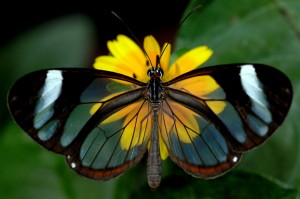Sometimes the biggest marvels we see in nature arise from the smallest unseen structures.

Lately, my work has revolved around understanding and explaining the science of the nanoscale world. As a result, I’ve had tiny things on my brain. And that’s just what nano means – tiny, really tiny, as in atoms and particles tiny. It’s one billionth of something. So, a nanometer is one billionth of a meter.

Despite the their size, nanoscale structures can have a big impact on how whole organisms look and function – just like the feathers of the peacock in the top photo. The nanoscale structures in the peacock’s feathers cause what’s know as structural color – when colors are formed not by pigment, but by the interaction of light with nano-structures.
Another amazing example of structural color in nature in the blue morpho butterfly. It earns its name, not from any blue pigment, but from colorless nanoscale structures that reflect blue light.

But nano-structures don’t just produce brilliant colors, they can also affect how an animal moves. The most notable example is the gecko. Geckos pretty much defy gravity, easily scrambling up a sheer vertical surface. The secret to their stickiness is in their toes. A gecko’s toes are packed with tiny hairs, called setae, and each of those hairs is further subdivided into nanoscale outgrowths. These minute structures lining their toes are so small they can latch onto a surface using molecular interactions called van der Waals forces. To move around, geckos simply change the position of their feet, releasing the adhesion. Check out this video to learn more:
Scientists study these amazing nanoscale structures to produce new forms of nanotechnology from bio-mimicry, like gecko-inspired adhesives, butterfly solar cells, and more. It seems now the tiniest structures in nature are leading to some of the biggest new discoveries in technology.

